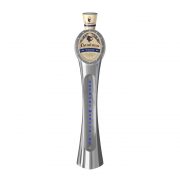2 weeks ago Like Ulysses, some beers have travelled a long way from the banks of the Euphrates, through Egypt, until reaching the Celtic and Gothic lands and spreading from Spain to the Urals before expanding into the Americas, India, China, and Australia. Beer has been around the world, much more so than wine, and in many cases has supplanted local beverages, because they are simply refreshing or invigorating. It took few adventurers and explorers, and some opportune flair to spread the recipes and the secrets of beer making overseas before international marketing did its work, (especially Belgian beers which remain the most famous!). John Martin did not want to deprive the Belgians of the astonishing flavour and myth of the “Guinness” and “dared” to import it in its original Irish version in 1914 and then in an “export” version. The “Guinness GXS ” was developed especially for him in Dublin with density and alcohol levels closer to those of Belgian brown specials. The symbol of the John Martin brewing company is a galleon … portraying the link between the exporting adventures of this brewer of Scottish origin, and the brewers’ thirst for commercial conquest. Of course there is the British. Based on the strength of the British Empire, they have largely contributed to the spread of good barley in the world. We owe them the creation of the India Pale Ale, or IPA, a beer “adapted” to long crossings and to conservation in the tropics, thanks to a significant addition of hop flowers at the end of the fermentation; a recipe rediscovered a few years ago by Anthony Martin, which is making a big comeback in bars and good restaurants today. Nor can we forget the Irish migrants and Guinness, their brewing symbol known internationally and the must-have drink for St. Patrick’s Day, all over the world, or the Dutch, tough competitors of the British on the seas. And what about the Germans, who were often the first to build breweries “in unknown lands”? While other colonizers preferred to import their beverages, the Germans often reproduced their rigorous blondes, low in alcohol but fresh, well suited to the heat they were confronted with. The Miller or Budweiser brands are also examples. Similarly, the Tsingtao beer, one of the first lagers to be consumed in China, owes its creation to the Germans who settled in the city in 1903. There is also the Cuzqueña in Peru, or the very popular Quilmes, created in 1888 in Argentina by German immigrants, often driven out of their country for economic or religious reasons. Even today, in spite of the global enthusiasm for the spread of local breweries (called craft brewers in the USA and in Canada in particular, that produce “Belgian Style” beers), Belgian beer continues to be known globally because of its reputation for quality. With exportation, 13 million hectolitres of Belgium beer crossed the borders in 2015, from both small and large brewers, representing approximately 62% of Belgian annual production. China is becoming an indispensable partner and consumer of Belgian beers, as is Russia, to the point that Russians today drink more beer than vodka (70% of men). In St Petersburg, more than 30 beer bars, mostly Belgian, have opened their doors where you can enjoy a Bourgogne des Flandres or Waterloo, but also authentic fruity lambic beers such as the Kriek Timmermans, generally preferred by woman. info@sweetglobe.be
Share:Original Source Here

